Kakadu & Top End
New Year in Kakadu
27 December 2018 - 1 January 2019
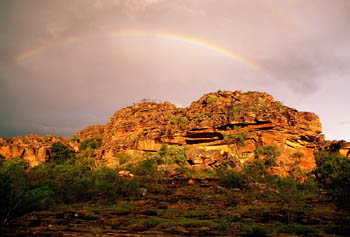
- Archaeologically important. An incredible wealth of Aboriginal art sites spanning the ages.
- Spectacular views. One of the most rugged landscapes in Kakadu.
- Beautiful campsites. There are so many wonderful campsites that it's hard to pick a favourite.
- Our photos speak for themselves. As you scroll down this page, you should get a good idea of what is like to participate in this trek.
Note. Click any photo to see a larger version. - Yellow Waters Cruise. See the crocs where it's safe to see them. No big crocs where we'll be walking.
- Price: $1450-1550.
The two people who booked and guaranteed the departure agreed to pay $2200 each. We offered a sliding scale depending on the final number. It's now down to one more and everyone pays only $1450.
Introduction
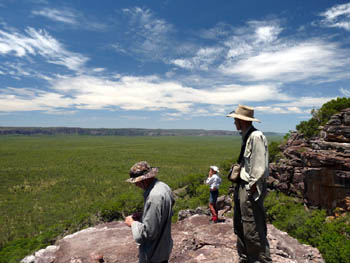
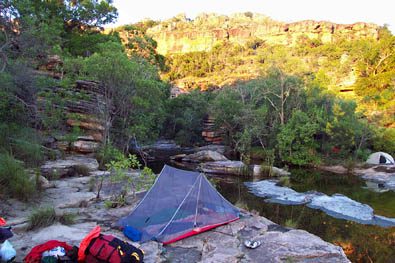
We collect the last arrivals from the Darwin airport about noon and head for Cooinda where we spend the first night. Next morning we do the Yellow Waters cruise giving you the chance to experience the wetlands in comfort. Cruise over, we do the short drive to the end of the Gubara track where we begin our walk.
Baroalba Creek is the main drainage for Mount Brockman, a large, irregularly shaped massif sitting on the plains a few kilometres away from the edge of the Arnhem escarpment. Its maximum dimensions are about 11 kilometres east to west and 15 kilometres north to south. Its maximum height is about 300 metres above sea level, about 240 metres above the surrounding plain.
While the edges of the massif are extremely rugged and steep, much of the centre consists of a large basin drained by Baroalba Creek. The rugged nature of the approaches prevented buffalo from reaching the basin, making this one of the few undisturbed areas in Kakadu.
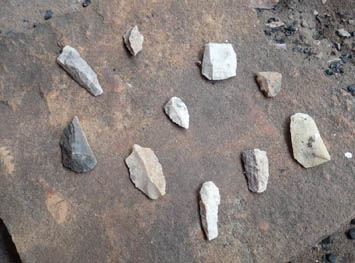
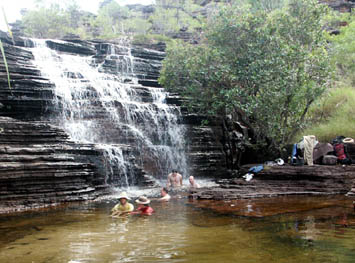
The area is full of rock shelters that were used by Aboriginal people over the millennia. It contains what may well be the greatest concentration of Aboriginal rock art in Australia, dating from the most ancient to the most recent. In deference to the wishes of the Aboriginal traditional owners, we do not show photos of the paintings on this website. We can, however, show you some of the discarded stone tools that litter the area. This was obviously a very important quarry for thousands of years.
The best time to visit this area is during or immediately after the wet season when every creek is flowing and the waterholes are all full.
Baroalba Creek and the Brockman Massif
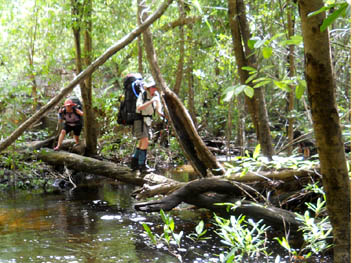
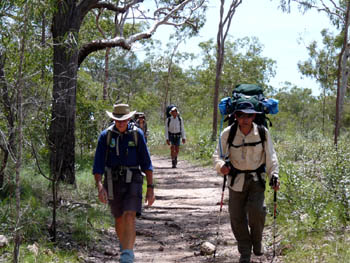
Our trek begins with an easy three kilometre hike along an old four wheel drive track to Gubara (Baroalba Springs) where we can enjoy a refreshing swim. From here, we leave all tracks behind. Depending on water levels and the wishes of the group, we may do a somewhat strenuous scramble up the boulder strewn creek or we may cross the creek and take a shortcut up another valley.
There are many possible campsites. Which one we choose will depend on how fast we are travelling. At this time of year, the many pools are too nice to resist. If we arrive early, there are plenty of places for the energetic to climb up for an afternoon view.
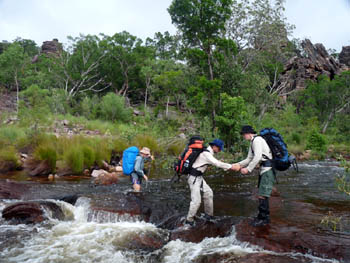
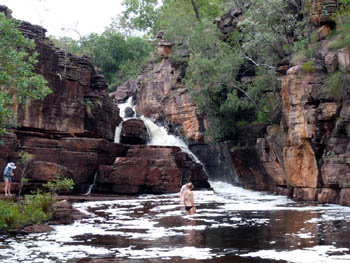
Part of the walk is moderately difficult. We cross and recross the creek, our exact route determined by the water levels at the time. The lovely chute waterfall shown in the photo is always worth a stop. When water levels are very low, we can go up next to the falls. If they are a bit higher, there is an easy, but slightly longer, way around.
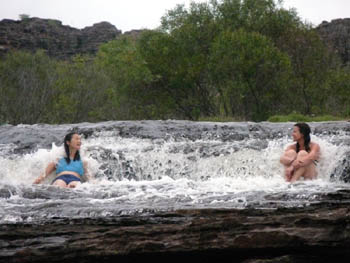
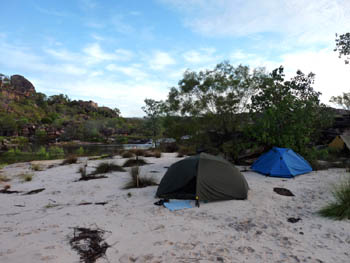
Once above the chute, the ground levels out and the walking becomes somewhat easier. We stop to visit art sites, photograph the flowers, climb up for views and relax by pools for swims as we work our way up to our second camp.
We will try and spend nights 2 and 3 in one camp and do a day walk from there.
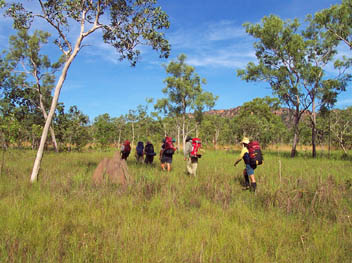
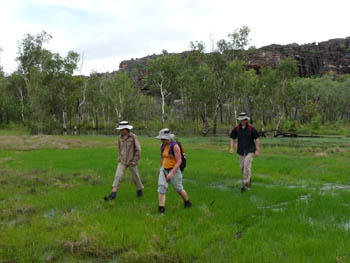
Now comes the easiest part of the trip. We camp here for two or even three nights, exploring the basin above with day packs. Here we find an incredible concentration of art sites as well as quarries containing the remains of discarded stone tools that didn't make the grade.
Much of the area is very flat. Sometimes it is very wet, sometimes it is relatively dry — relatively. This is still the wet season so water is everywhere.
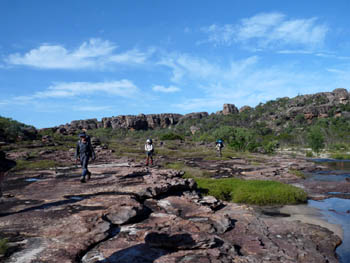
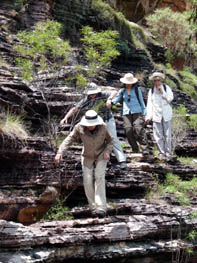
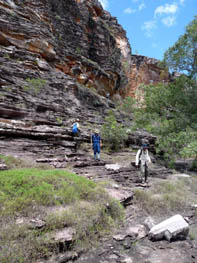
Sometimes we walk on flat rock ledges and sometimes we do some fairly steep climbs. The views are magnificent.
We can make the day walk as easy or as energetic as the members of the group wish. While we won't let anyone wander off on their own, if a few people want to do something more strenuous than the rest and climb higher for a better view, they can do so.
On the final full day, we return back the way we came to a final campsite next to a pool. From there, a relatively short walk brings us back to the car and the drive back to Darwin, probably arriving late afternoon on New Year's Day.
Flora and Fauna
This is the best time of year for wildflowers. While you are unlikely to see many large animals, if you keep your eyes open, you will see lots of small ones.
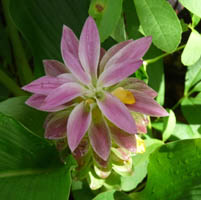
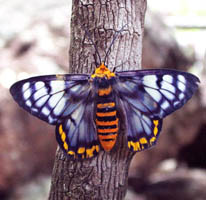
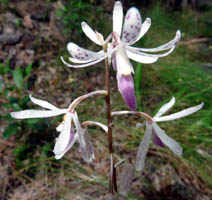
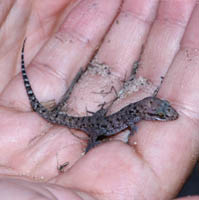
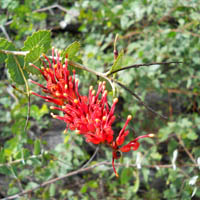
Terrain and difficulty.
As the photos show, this trip includes some of easiest as well as some of the most rugged terrain in our entire program. The reasons it is only rated as level 3 are the leisurely pace and the fact that the most difficult climbs can be done without a full pack.
It is likely to rain during the trip. If you take part, you will get wet when it rains.
It will be hot. The average daily maximum temperature in December-January is 34-35°C (94-95°F). To avoid the worst of the heat, we plan to take long breaks near pools during the middle of the day whenever possible.
You are, however, not likely to get cold. The lowest temperature ever recorded in Jabiru, the nearest town was 21°C (70°F). The average minimum is 24-25°C (75-77°F)
Once you start, you are in to the finish. There is no vehicular access anywhere along the route.
Most of the walk is fairly flat and relatively easy. Some parts, however, involve considerable rock hopping and are moderately difficult. There are a few steep climbs but these are short and over relatively quickly for most groups.
To take part you need good fitness, a sense of adventure and an interest in Aboriginal art and the natural landscape.
Your rewards include visits to an incredible number of Aboriginal art sites, spectacular views, great swimming and beautiful campsites shared with no one but your own small group, a Kakadu wilderness experience no other operator can offer you.
This is a wet season trip. More information about bushwalking in the wet season
For more information about this trip or to find out how to book email us for New Year in Kakadu Information
 share
share